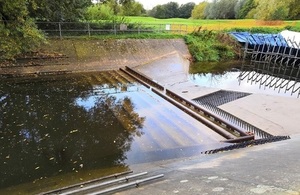Helping fish and eels along their journey
A specially designed fish pass could be rolled out across Essex to allow fish to travel more easily through rivers.

The weir structure on the River Colne
The Environment Agency project was aimed to help fish and eels navigate safely over the weir structure on the River Colne while ensuring that the flood risk and water resources data collected by the Earls Colne gauging station was unaffected.
However given the unusual shape of the gauging weir, it was a complicated fish pass to design, with the added issue of having to dry a section of the river out for the work to be completed.
Despite a setback during the construction, where some vital tools and a JCB was stolen, the design was still successfully completed in just four weeks.
Contractors carried out the work, which involved fixing low cost baffles (a structure to redirect the flow of water) and eel tiles to the weir. However to ensure this was done accurately and safely, the work area had to be dried out for the duration of the work.
A dam was constructed upstream and downstream and large pumps were used to bypass the structure. As the water levels were slowly lowered while the work area was being dried out, the contractor safely relocated the fish and eels that remained by the weir.
An Environment Agency spokesperson said:
Two eels were found downstream of the structure while the contractors were drying out the work area. This is really encouraging as it demonstrates that they can get as far as Earls Colne. The new eel pass should now help them further up the catchment.
We are excited to have completed the project and we are looking forward to the next step where we will be monitoring the flow data and surveying the fish populations to see if it can be rolled out elsewhere.
This weir is one of 22 Essex Profile weirs, which means it has a particularly unusual shape. The fish pass was specifically designed to fit this shape and if it proves to be successful, it can be replicated on other structures. Man-made structures can obstruct fish from moving freely around the river system. If fish cannot reach their spawning or feeding habitat, then they cannot build their populations and numbers decline. Where it is not possible to remove an obstruction, a fish pass is a favourable option.
The European eel is a well-known example of a declining species. Numbers have fallen 95% over the last 30 years and by adding eel tiles to the fish pass, this will help this protected species to continue its fascinating life cycle.